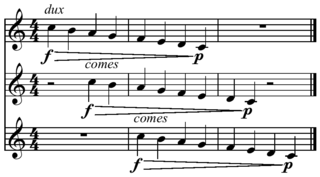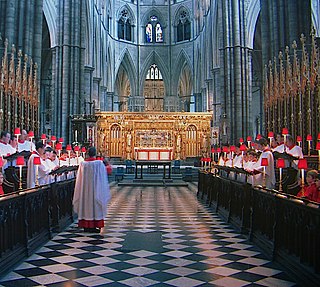Related Research Articles
Dactylic hexameter is a form of meter or rhythmic scheme in poetry. It is traditionally associated with the quantitative meter of classical epic poetry in both Greek and Latin and was consequently considered to be the grand style of Western classical poetry. Some premier examples of its use are Homer's Iliad and Odyssey, Virgil's Aeneid, and Ovid's Metamorphoses. Hexameters also form part of elegiac poetry in both languages, the elegiac couplet being a dactylic hexameter line paired with a dactylic pentameter line.
In poetry, metre (British) or meter is the basic rhythmic structure of a verse or lines in verse. Many traditional verse forms prescribe a specific verse metre, or a certain set of metres alternating in a particular order. The study and the actual use of metres and forms of versification are both known as prosody.

Medieval music consists of songs, instrumental pieces, and liturgical music from about 500 A.D. to 1400. Medieval music was an era of Western music, including liturgical music used for the church, and secular music, non-religious music. Medieval music includes solely vocal music, such as Gregorian chant and choral music, solely instrumental music, and music that uses both voices and instruments. Gregorian chant was sung by monks during Catholic Mass. The Mass is a reenactment of Christ's Last Supper, intended to provide a spiritual connection between man and God. Part of this connection was established through music. This era begins with the fall of the Western Roman Empire in the fifth century and ends sometime in the early fifteenth century. Establishing the end of the medieval era and the beginning of the Renaissance music era is difficult, since the trends started at different times in different regions. The date range in this article is the one usually adopted by musicologists.
A rhyme is a repetition of similar sounds in the final stressed syllables and any following syllables of two or more words. Most often, this kind of "perfect" rhyming is consciously used for effect in the final positions of lines of poems and songs. More broadly, a rhyme may also variously refer to other types of similar sounds near the ends of two or more words. Furthermore, the word rhyme has come to be sometimes used as a shorthand term for any brief poem, such as a rhyming couplet or nursery rhyme.
Semiology is a branch of Gregorian Chant research. Semiology refers specifically to the study of the neumes as found in the earliest fully notated manuscripts of Gregorian Chant, the oldest of which have been dated to the 9th century. The first application of the term 'semiology' for the study of Latin chant was made by Dom Eugène Cardine (1905–1988), a monk of the Abbey of Solesmes. In this context, 'semiology' is understood as 'the study of musical signs'. Text and neumatic notation, together with significative letters adjoined to the neumes, presents an effective and integrated mnemonic for the rhythmical interpretation and the melody. While Gregorian palaeography offers a description of the various neumes and their rhythmical and melodic values, Gregorian semiology explains their meaning for practical interpretation.

Gregorian chant is the central tradition of Western plainchant, a form of monophonic, unaccompanied sacred song in Latin of the Roman Catholic Church. Gregorian chant developed mainly in western and central Europe during the 9th and 10th centuries, with later additions and redactions. Although popular legend credits Pope Gregory I with inventing Gregorian chant, scholars believe that it arose from a later Carolingian synthesis of Roman chant and Gallican chant.

"Ut queant laxis" or "Hymnus in Ioannem" is a Latin hymn in honor of John the Baptist, written in Horatian Sapphics and traditionally attributed to Paulus Diaconus, the eighth-century Lombard historian. It is famous for its part in the history of musical notation, in particular solmization. The hymn belongs to the tradition of Gregorian chant.
In music, a coda is a passage that brings a piece to an end. Technically, it is an expanded cadence. It may be as simple as a few measures, or as complex as an entire section.

In music, a canon is a contrapuntal (counterpoint-based) compositional technique that employs a melody with one or more imitations of the melody played after a given duration. The initial melody is called the leader, while the imitative melody, which is played in a different voice, is called the follower. The follower must imitate the leader, either as an exact replication of its rhythms and intervals or some transformation thereof. Repeating canons in which all voices are musically identical are called rounds—"Row, Row, Row Your Boat" and "Frère Jacques" are popular examples.

Perotinus Magnus, was a composer from around the late 12th century, associated with the Notre Dame school of polyphony in Paris and the ars antiqua musical style. The title Magister Perotinus means that he was licensed to teach. The only information on his life with any degree of certainty comes from an anonymous English student at Notre Dame known as Anonymous IV. It is assumed that he was French and named Pérotin, a diminutive of Peter, but attempts to match him with persons in other documents remain speculative.
Organum is, in general, a plainchant melody with at least one added voice to enhance the harmony, developed in the Middle Ages. Depending on the mode and form of the chant, a supporting bass line may be sung on the same text, the melody may be followed in parallel motion, or a combination of both of these techniques may be employed. As no real independent second voice exists, this is a form of heterophony. In its earliest stages, organum involved two musical voices: a Gregorian chant melody, and the same melody transposed by a consonant interval, usually a perfect fifth or fourth. In these cases the composition often began and ended on a unison, the added voice keeping to the initial tone until the first part has reached a fifth or fourth, from where both voices proceeded in parallel harmony, with the reverse process at the end. Organum was originally improvised; while one singer performed a notated melody, another singer—singing "by ear"—provided the unnotated second melody. Over time, composers began to write added parts that were not just simple transpositions, thus creating true polyphony.
In late medieval Western music, a clausula was a newly composed polyphonic section for two or more voices sung in discant style over a cantus firmus. Clausulae eventually became used as substitutes for passages of original plainchant. They occur as melismatic figures based on a single word or syllable within an organum. The text of a clausula differs from that of the plainchant melody underneath it. Each clausula is clearly delineated by a final cadence.

In medieval music, conductus is a type of sacred, but non-liturgical vocal composition for one or more voices. The word derives from Latin conducere, and the conductus was most likely sung while the lectionary was carried from its place of safekeeping to the place from which it was to be read. The conductus was one of the principal types of vocal composition of the ars antiqua period of medieval music history.

A neume is the basic element of Western and Eastern systems of musical notation prior to the invention of five-line staff notation.

Anglican chant, also known as English chant, is a way to sing unmetrical texts, including psalms and canticles from the Bible, by matching the natural speech-rhythm of the words to the notes of a simple harmonized melody. This distinctive type of chant is a significant element of Anglican church music.
Scansion, or a system of scansion, is the method or practice of determining and (usually) graphically representing the metrical pattern of a line of verse. In classical poetry, these patterns are quantitative based on the different lengths of each syllable. In English poetry, they are based on the different levels of stress placed on each syllable. In both cases, the meter often has a regular foot. Over the years, many systems have been established to mark the scansion of a poem.
Franco of Cologne was a German music theorist and possibly a composer. He was one of the most influential theorists of the late Medieval era, and was the first to propose an idea which was to transform musical notation permanently: that the duration of any note should be determined by its appearance on the page, and not from context alone. The result was Franconian notation.

In medieval music, the rhythmic modes were set patterns of long and short durations. The value of each note is not determined by the form of the written note, but rather by its position within a group of notes written as a single figure called a "ligature", and by the position of the ligature relative to other ligatures. Modal notation was developed by the composers of the Notre Dame school from 1170 to 1250, replacing the even and unmeasured rhythm of early polyphony and plainchant with patterns based on the metric feet of classical poetry, and was the first step towards the development of modern mensural notation. The rhythmic modes of Notre Dame Polyphony were the first coherent system of rhythmic notation developed in Western music since antiquity.

Mensural notation is the musical notation system used for European vocal polyphonic music from the later part of the 13th century until about 1600. The term "mensural" refers to the ability of this system to describe precisely measured rhythmic durations in terms of numerical proportions between note values. Its modern name is inspired by the terminology of medieval theorists, who used terms like musica mensurata or cantus mensurabilis to refer to the rhythmically defined polyphonic music of their age, as opposed to musica plana or musica choralis, i.e., Gregorian plainchant. Mensural notation was employed principally for compositions in the tradition of vocal polyphony, whereas plainchant retained its own, older system of neume notation throughout the period. Besides these, some purely instrumental music could be written in various forms of instrument-specific tablature notation.

The Bamberg Codex is a manuscript containing two treatises on music theory and a large body of 13th-century French polyphony.
References
- New Grove Dictionary of Music
- Richard Taruskin, ed., Oxford History of Western Music (Oxford: Oxford University Press, 2005) Volume 1.